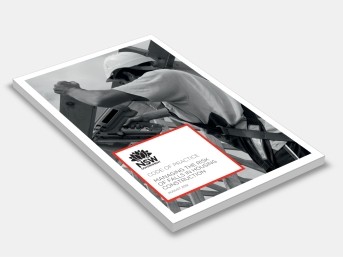Code of Practice Managing the risk of falls in housing construction
SafeWork NSW
This Code of Practice on how to manage the risk of falls in housing construction is an approved code of practice under section 274 of the Work Health and Safety Act (the WHS Act).
An approved code of practice provides practical guidance on how to achieve the standards of work health and safety required under the WHS Act and the Work Health and Safety Regulation (the WHS Regulation) and effective ways to identify and manage risks.
A code of practice can assist anyone who has a duty of care in the circumstances described in the code of practice. Following an approved code of practice will assist the duty holder to achieve compliance with the health and safety duties in the WHS Act and WHS Regulation, in relation to the subject matter of the code of practice. Like regulations, codes of practice deal with particular issues and may not cover all relevant hazards or risks. The health and safety duties require duty holders to consider all risks associated with work, not only those for which regulations and codes of practice exist.
Codes of practice are admissible in court proceedings under the WHS Act and
WHS Regulation. Courts may regard a code of practice as evidence of what is known about a hazard, risk, risk assessment or risk control and may rely on the code in determining what is reasonably practicable in the circumstances to which the code of practice relates.
For further information see the Interpretive Guideline: The meaning of ‘reasonably practicable’.
Compliance with the WHS Act and WHS Regulation may be achieved by following another method if it provides an equivalent or higher standard of work health and safety than
the code.
An inspector may refer to an approved code of practice when issuing an improvement or prohibition notice.
This Code is intended to be read by a person conducting a business or undertaking (PCBU). It provides practical guidance for PCBUs on how to eliminate, or if that is not possible, minimise the risk of falls from height in housing construction.
This Code applies to all workplaces covered by the WHS Act carrying out the construction or extension of:
- detached houses
- attached dwellings, separated from each other by a fire resisting wall, such as
terrace, row or town houses
- boarding and guest houses, hostels or similar with a floor area less than 300 m2, and
- ancillary buildings to the above, such as private garages, gazebos and carports.
Note: The above points are based on Classes 1, 2 and 10 of the National Construction Code.
This Code does not apply to the maintenance or renovation of buildings or to multistorey buildings above two habitable storeys.
This Code is not intended as complete guidance where roofing work involves dismantling or demolition work.
This Code may be a useful reference for other persons interested in the duties under the WHS Act and WHS Regulation.
Contents:
1: Introduction
2: Managing The Risk Of Falls
3: Work On The Ground Or On A Solid Construction
4: Fall Prevention Devices
5: Work Positioning Stations
6: Fall Arrest Systems
7: Administrative Controls
8: Use Of Portable Ladders
9: Safe Work Methods For Common Tasks
10: Roofing Tasks
Appendix A: Glossary
Appendix B: Referenced Documents And Further Reading
Appendix C: Timber Scaffolds
